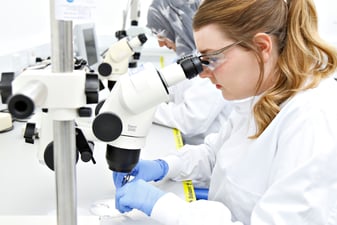Mesenchymal Stem Cells (MSCs; also called Mesenchymal Stromal Cells or Medicinal Signaling Cells) were originally discovered in the bone marrow more than half a century ago 1. They were described as fibroblast-like cells capable of osteogenesis in diffusion chambers 2. The study by Pittenger et al., published in 1999, 3 was pivotal in establishing the potential of MSCs to differentiate into multiple cell types (multipotent nonhematopoietic progenitor cells), including chondrocytes (cartilage cells), osteoblasts (bone cells), and adipocytes (fat cells). MSCs have the ability to proliferate and maintain their mesodermal multipotent state over multiple passages, as described by Song et al, in their study which focuses on identifying and analyzing candidate genes that regulate the self-renewal and multipotency of MSCs 4. MSCs have traditionally been sourced from various tissues in the body such as bone marrow, adipose tissue, dental pulp, umbilical cord blood and its mucous connective tissue (including Wharton’s jelly) or placenta.
Recent scientific advancements have introduced a groundbreaking method: Directed differentiation of induced pluripotent stem cells (iPSCs) towards MSC lineage cells, known as iMSCs. This blog will delve into the clinical benefits of iMSCs and elucidate why they are increasingly favored by researchers and clinicians globally.
Why Are MSCs Key to Stem Cell Therapy?
The ability of MSCs to self-renew and differentiate into several cell types of the mesodermal lineage (bone cells or osteoblasts, chondrocytes (cartilage cells), adipocytes (fat cells), connective tissue, muscle, etc.), their potent immunomodulatory properties and low immunogenicity, have made them an attractive candidate for the development of cell therapies with various indications. In addition, MSCs have a significant role in tissue repair and regeneration 5. Apart from their immunomodulatory properties, MSCs also support hematopoiesis, and aid the regeneration of damaged tissues, allowing the use of HLA-mismatched MSCs in stem cell therapy 6. Numerous clinical trials exploring the therapeutic potential of MSCs have demonstrated their safety for clinical use 7.
Extracellular vesicles (EVs), commonly known as exosomes, containing bioactive molecules are secreted from all cells including MSCs. These factors enhance the positive cellular effects of MSCs by creating a favorable and supportive microenvironment fostering their protective and pro-regenerative properties. However, EVs are considered to have a low risk profile associated with cell transplantation such as tumorigenicity and small vessel occlusion. Consequently, EVs hold great promise for the advancement of cell-free therapeutic approaches 8.
What are iMSCs and How Do Their Benefits Compare to Conventional Primary MSCs?
The generation of iPSCs by Professor Shinya Yamanaka’s team at Kyoto University in Japan 9 revolutionized the field of stem cell research and regenerative medicine as a whole. This breakthrough described a specific set of reprogramming factors that can transform an adult cell into an iPSC. During the reprogramming process, the somatic cell is reverted to a pluripotent state, regaining the potential to differentiate into almost any cell type found in the body originating from the three germ layers (ectoderm, mesoderm, and endoderm). One possible way to reprogram a somatic cell into an iPSC is using non-integrative mRNA. Verma and colleagues (2019) 10 used StemRNA™ 3rd Gen RNA Reprogramming Technology to create iPSCs, that were further differentiated into iMSCs.
%20cells-1.png?width=608&height=456&name=ReproMSC3%20(RCRP025)%20cells-1.png)
Figure 1. Microscopic image of iMSCs.
The image highlights the characteristic morphology of iMSCs, including spindle-shaped fibroblast-like cells.
iMSCs (Figure 1) provide a solution to the multiple challenges associated with tissue-derived MSCs 11. This concept of generating iMSCs as an alternative to MSCs derived from primary tissues opens the possibility of creating an abundant and consistent supply of customizable, homogenous MSC-equivalent cells that can be used for research and in clinical settings. A growing body of scientific evidence highlights the benefits of iMSCs over primary MSCs, particularly in the development of allogeneic, off-the-shelf cell therapeutics (Figure 2).

Figure 2. Therapeutic potential of MSCs compared to iMSCs.
Comparison of the in vitro potential for clinical use of MSCs and iMSCs.
Consistency, Standardization, Scalability & Cost-Effectiveness in Stem Cell Research
Batch-to-batch variability and consequent cellular heterogeneity of primary MSCs often make it challenging to standardize experiments, procedures, and protocols, thus complicating the evaluation of safety and efficacy in potential MSC-based therapies. Additionally, these primary MSC lots are sourced from different donors, further increasing biological variability, especially concerning their immunomodulatory properties.
Since iMSCs are a product of in vitro differentiation of iPSCs, which can be propagated indefinitely, this provides an unlimited and consistent source of starting cell material 12. The inherent scalability of iPSCs enables the large-scale production of iMSCs (Figure 3), ensuring greater homogeneity, robustness, and reproducibility in both clinical and research settings. The ability to create large master cell banks (MCBs) or working cell banks (WCBs) of iMSCs makes their generation more cost-effective over time compared to traditional primary MSCs. This scalability is essential for advancing both research and therapeutic applications.
The same is valid for exosomes derived from primary MSC versus iMSCs. iMSCs provide a consistent and robust supply of standardized exosomes.

Figure 3. Scalable clinical iMSC Production in an MCB. Our state-of-the-art facility, where highly skilled lab staff create large MCBs of iMSCs. By leveraging advanced biomanufacturing techniques, we ensure cost-effective production over time and consistent quality, supporting therapeutic applications.
Ethical and Safety Concerns
Ethical and safety concerns differ significantly between primary MSCs and iMSCs. Primary MSCs are typically harvested from donor tissues such as bone marrow or adipose tissue and exhibit high biological inter-donor variability, raising ethical issues related to donor consent and the invasive nature of the extraction process. MSCs obtained from fetal temporary organs such as the umbilical cord, present a unique ethical challenge, as consent is given by the mother rather than the donor, and upon reaching adulthood the donor would have the choice to withdraw consent. Umbilical cord-derived MSCs offer advantages in therapy due to their lower immunogenicity and greater potential for allogeneic applications, however traditional MSC-based therapies still face limitations in this regard 13.
In contrast, iMSCs, derived from iPSCs, mitigate these ethical concerns and offer a more homogeneous and consistent cell source, thus enabling the development of off-the-shelf allogeneic therapy options.
Regenerative Potential
iMSCs have demonstrated strong potential in regenerative medicine exhibiting enhanced therapeutic outcomes compared to their tissue-derived counterparts in various animal models of human diseases such as Chronic Obstructive Pulmonary Disease (COPD) and Inflammatory Bowel Disease (IBD) 14, 15.
The versatility, robustness, and ethical advantages of iMSCs make them an ideal candidate for clinical applications. iMSCs are being explored in clinical trials for their therapeutic effects, including reducing inflammation, promoting tissue repair, enhancing immune tolerance, supporting healing in damaged tissues, and modulating disease-associated pathways 11. iMSCs demonstrate therapeutic potential across various diseases—including IBD 16, cancer 17, airway inflammation 18, periodontal disease 19, and transplantation 20, graft-versus-host disease or GVHD 13.
Gene editing
iPSCs are particularly well-suited for gene editing because they can proliferate indefinitely and have well-established protocols. This makes them an ideal platform for precisely integrating therapeutic genes into well-defined regions of the genome, reducing the risk of harmful off-target mutations and ensuring stable gene function 21.
Utilizing iPSC as starting material for gene-editing creates a unique opportunity to customize not only the iMSC genetic profile with potential knock in or knock out of specific genes but also modulate the EVs composition in such manner.
In contrast, while modern tools like CRISPR-Cas9 can directly edit primary MSCs, their limited proliferation capacity makes scaling and quality control (QC) more challenging. Tissue-derived MSCs often reach their replicative limits before sufficient clones can be expanded, and higher passage numbers can lead to genomic instability, loss of differentiation potential, and increased risks of malignant transformation 22, 23.
By leveraging iPSCs as the starting material, extensive QC, single-cell cloning and master cell bank generation can be performed before MSC-directed differentiation, and the iMSC production sidesteps these challenges, enabling consistent, scalable gene-editing workflows with reduced biological risks. This ensures robust and reproducible outcomes, making iMSCs a superior platform for therapeutic applications requiring genetic modification.
Conclusion
The advent of iMSCs marks a transformative step forward in regenerative medicine and therapeutic development. By overcoming key limitations of traditional tissue-derived MSCs including high lot-to-lot variability, limited proliferation capacity, and significant biological heterogeneity, iMSCs offer a scalable, consistent, and ethically sound alternative for research and clinical applications. Their versatility, ranging from personalized medicine potential and enhanced regenerative capabilities to ease of genetic editing, positions iMSCs as a promising solution for advancing treatments for various diseases, including IBD, GVHD, cancer, airway inflammation, and beyond.
REPROCELL’s MSC Capabilities
At REPROCELL, we are committed to driving innovation in stem cell technology. With an extensive range of clinical-grade and research-grade cell lines including MSCs, iMSCs, and iPSCs, as well as our custom cell line manufacturing services, we aim to empower researchers and clinicians with cutting-edge tools to unlock the full therapeutic potential of stem cell science.
Explore the links below to learn more about our MSC capabilities, product catalog, and clinical MSC applications:
- GMP iPSC/iMSC MCB Manufacturing – REPROCELL USA
- GMP iPSC/MSC MCB Manufacturing – Histocell (Europe Partner Overview)
- Ready to use GMP Mesenchymal Stem Cells
- Products: Mesenchymal Stem Cells (MSCs)
- FAQ - Clinical MSCs
Stay tuned for updates as we continue to expand our clinical-grade offerings!
References
-
Berg, R. B and Rosenthal, M. S. Studies of Fibroblastic Cells Cultivated from Bone Marrow of Leukemic and Non-Leukemic Patients. Proceedings of the Society for Experimental Biology and Medicine. 3:614-617 (1961).
-
Friedenstein, A.J., Chailakhjan, R. K., Lalykina, K. S. The development of fibroblast colonies in monolayer cultures of guinea-pig bone marrow and spleen cells. Cell Proliferation in basic and clinical sciences, 3: 393-403 (1970).
-
Pittenger, M. F., Mackay, A. M., Beck, S. C., Jaiswal, R. K., Douglas, R., Mosca, J.D., Moorman, M. A., Simonetti, D. W., Craig, S. and Marshak, D. R. Multilineage potential of adult human mesenchymal stem cells. Science. 284:143-7 (1999).
-
Song, L., Webb, N. E., Song, Y. and Tuan, R. S. Identification and Functional Analysis of Candidate Genes Regulating Mesenchymal Stem Cell Self‐Renewal and Multipotency, Stem Cells, 24: 1707–1718 (2006).
-
Wu, X., Jiang, J., Gu, Z., Zhang, J., Chen, Y. and Liu, X. Mesenchymal stromal cell therapies: immunomodulatory properties and clinical progress. Stem Cell Res Ther 11, 345 (2020).
-
Le Blanc, K., Tammik, C., Rosendahl, K., Zetterberg, E. and Ringden,O. HLA expression and immunologic properties of differentiated and undifferentiated mesenchymal stem cells. Exp Hematol, 31 (2003).
-
Wang, Y., Yi, H. and Song, Y. The safety of MSC therapy over the past 15 years: a meta-analysis. Stem Cell Research & Therapy, 12 (2021).
-
Dabrowska, S., Andrzejewska, A., Janowski, M. and Lukomska, B. Immunomodulatory and regenerative effects of mesenchymal stem cells and extracellular vesicles: Therapeutic outlook for inflammatory and degenerative diseases. Front. Immunol. 11 (2021).
-
Takahashi, K. and Yamanaka, S. Induction of pluripotent stem cells from mouse embryonic and adult fibroblast cultures by defined factors. Cell, 126, 663 – 676 (2006).
-
Verma, R., Saengmuang, P., Payuha, T., Mendoza, J. D., Narang, R., Bondee, N., Dmitrievs, S., and Collier, P. M. Robust, efficient and pure induced mesenchymal stem cells generation from mRNA induced pluripotent stem cells in suspension. Journal of Stem Cell Research & Therapy, 9, (2019).
-
Zhou, X., Liu, J., Wu, F., Mao, J., Wang, Y., Zhu, J., Hong, K., Xie, H., Li, B., Qiu, X., Xiao, X. and Wen, C. The application potential of iMSCs and iMSC-EVs in diseases. Front. Bioeng. Biotechnol, 12 (2024).
-
Zhang, J., Chen, M., Liao, J., Chang, C., Liu, Y., Padhiar, A., Zhou, Y. and Zhou, G. Induced pluripotent stem cell-derived mesenchymal stem cells hold lower heterogeneity and great promise in biological research and clinical applications. Frontiers in Cell and Developmental Biology, 9, 716907 (2021).
-
Jiang, E., Qian, K., Wang, L., Yang, D., Shao, Y., Hu, L., Li, Y., Yao, C., Han, M., Hou, X., & Liu, D. Efficacy and safety of human umbilical cord-derived mesenchymal stem cells versus placebo added to second-line therapy in patients with steroid-refractory acute graft-versus-host disease: a multicentre, randomized, double-blind, phase 2 trial. BMC medicine, 22 (2024).
-
Fernandez-Rebollo, E., Franzen, J., Goetzke, R., Rath, B., Kornfeld, J. and Wagner, W. Senescence-associated metabolomic phenotype in primary and iPSC-derived mesenchymal stromal cells. Stem Cell Reports, 14, 201 – 209 (2020).
-
Wu, Z., Su, Y., Li, J., Liu, X., Liu, Y., Zhao, L., Li, L. and Zhang, L. Induced pluripotent stem cell-derived mesenchymal stem cells: whether they can become new stars of cell therapy. Stem Cell Res Therapy,15, 367 (2024).
-
Kagia, A., Tzetis, M., Kanavakis, E., Perrea, D., Sfougataki, I., Mertzanian, A., Varela, I., Dimopoulou, A., Karagiannidou, A. and Goussetis, E. Therapeutic effects of mesenchymal stem cells derived from bone marrow, umbilical cord blood, and pluripotent stem cells in a mouse model of chemically induced inflammatory bowel disease. Inflammation,42, 1730–1740 (2019).
-
Wang, Z., Chen, H., Wang, P., Zhou, M., Li, G., Hu, Z., Hu, Q., Zhao, J., Liu, X., Wu, L. and Liang, D. Site-specific integration of TRAILin iPSC-derived mesenchymal stem cells for targeted cancer therapy. Stem Cells Translational Medicine, 11, 297–309 (2022).
-
Zhong H, Fan XL, Fang SB, Lin YD, Wen W, Fu QL. Human pluripotent stem cell-derived mesenchymal stem cells prevent chronic allergic airway inflammation via TGF-β1-Smad2/Smad3 signalling pathway in mice. Mol Immunol. 109:51-57 (2019).
-
Hynes, K., Bright, R., Marino, V., Ng, J., Verma, P.J., Gronthos, S. and Bartold, P. M. Potential of iPSC-derived mesenchymal stromal cells for treating periodontal disease. Stem Cells Int. (2018).
-
Cheng, P. P., Liu, X.C,, Ma, P.F., Gao C, Li, J.L., Lin, Y.Y., Shao, W., Han, S., Zhao, B., Wang, L.M., Fu, J.Z., Meng, L.X., Li, Q., Lian, Q.Z., Xia, J.J. and Qi, Z. Q. iPSC-MSCs combined with low-dose rapamycin induced islet allograft tolerance through suppressing Th1 and enhancing regulatory T-cell differentiation. Stem Cells Dev. 24:1793-804 (2015).
-
Zhao, Q., Gregory, C. A., Lee, R.H., Liu, F., Regger, R. L., Qin, L., Hai, B., Park, M. S., Yoon, N., Clough, B., McNeil, E. and.0 Prockop, D. J. MSCs derived from iPSCs with a modified protocol are tumor-tropic but have much less potential to promote tumors than bone marrow MSCs. Proceedings of the national academy of sciences, 112 (2015).
-
Musiał-Wysocka, A., Kot, M. and Majka, M. The pros and cons of mesenchymal stem cell-based therapies. Cell transplant, 28, 801-812 (2019).
-
Kim, M., Rhee, J., Choi, H., Kwon, A., Kim, J., Dong Lee, G., Wook Jekarl, D., Lee, S., Kim, Y. and Kim, T. Passage-dependant accumulation of somatic mutations in mesenchymal stromal cells during in vitro culture revealed by whole genome sequencing. Sci Rep, 7, 14508 (2017).






.jpg?width=1000&height=562&name=Untitled%20design%20(5).jpg)

